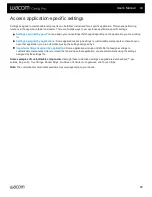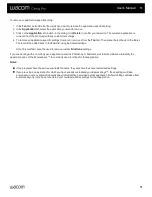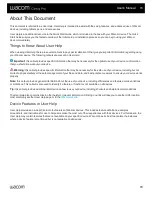
If nothing appears on the screen after you have connected your pen display to your computer and installed the driver, check the
following connections and elements.
1. Turn on your computer and wait until it is ready to use.
2. Verify that any power cables or adapters are properly connected, and that their LED status lights are on.
3. If your pen display is connected to your computer, check the USB connection.
Make sure the USB cable is securely connected to an active USB port on your computer.
Check the pen display USB cable for damage.
If you are connecting the pen display to a USB hub (or hub device with USB ports), be sure the USB hub is properly
connected to your computer and is active.
If a status LED does not illuminate after your computer is on and has finished booting up, your USB port may be
disabled. Verify that you have connected the pen display to an active USB port.
Connect the pen display to a different USB port, or to a USB port on another computer, and see if the problem
persists.
For best results when troubleshooting no power to the pen display, plug it directly into the USB port on your
computer.
Temporarily eliminate any external hubs in use until you determine that the system recognizes the pen display and
that it is functional. When the pen display is working properly, you can then usually move its connection to a USB hub.
4. Test touch, if your pen display supports touch. Attempt to move the screen cursor by tracking your finger across the
surface. Then tap to select an item.
If the driver does not load properly, basic touch movement will be recognized, but other actions and gestures will not.
If gestures are not recognized, re-install the driver.
5. Check the ExpressKeys™ and Rocker Ring.
6. Check any other tool(s) you may be using.
7. If any of these tests fail, you may have defective hardware. See
.
to reconfigure your pen display and tools for any custom settings you may
have been using.
User's Manual
63
63























